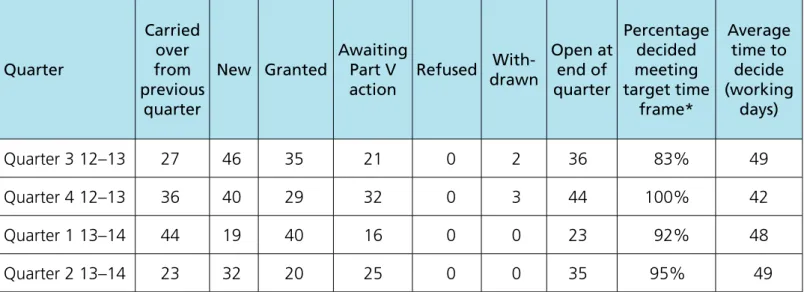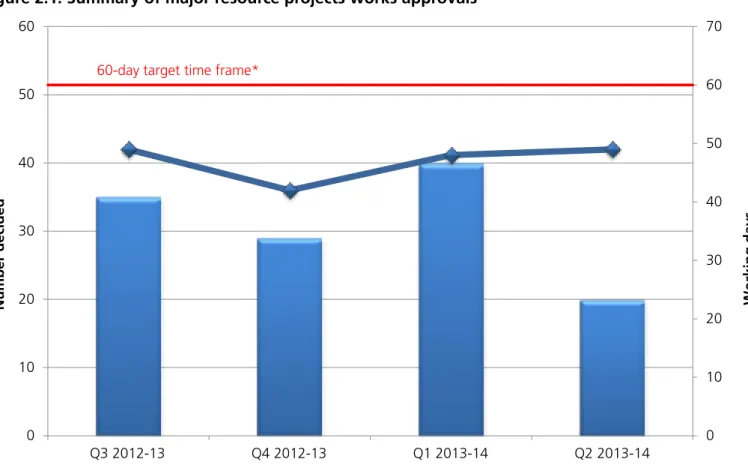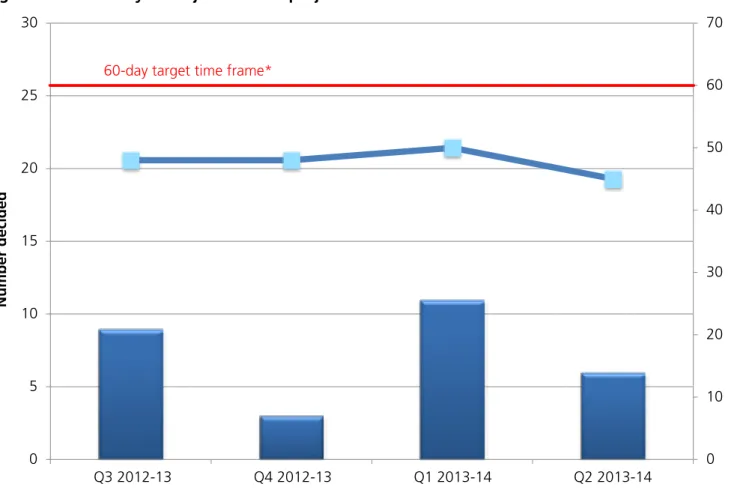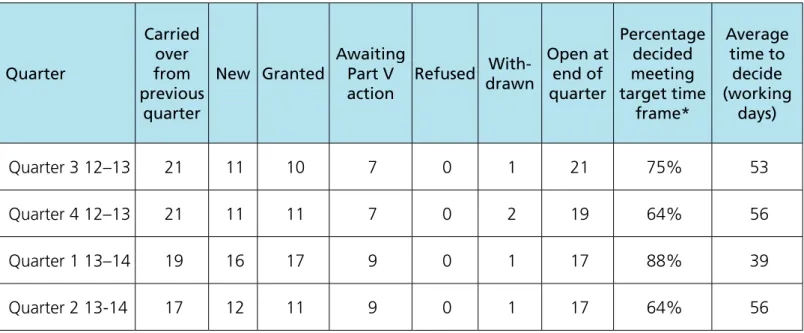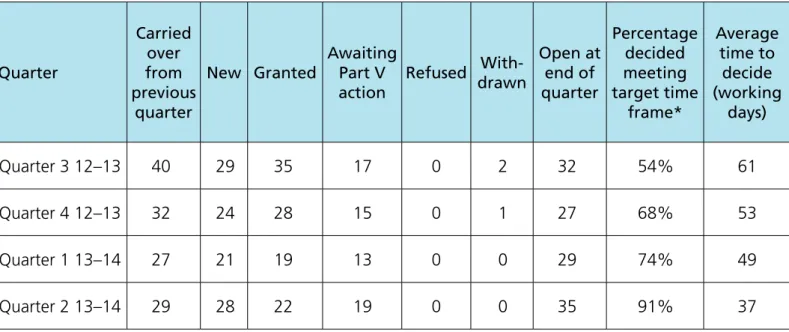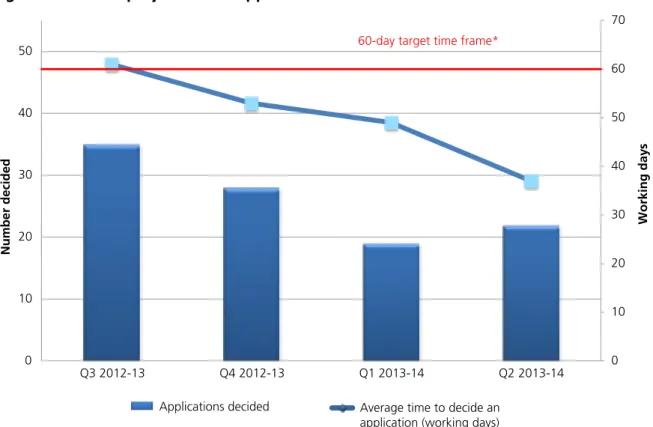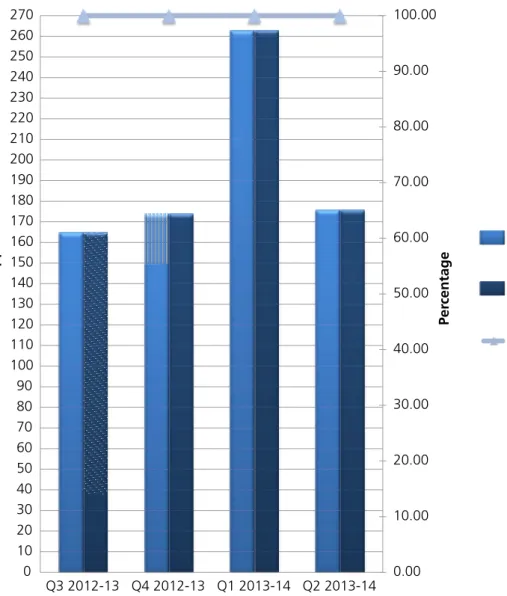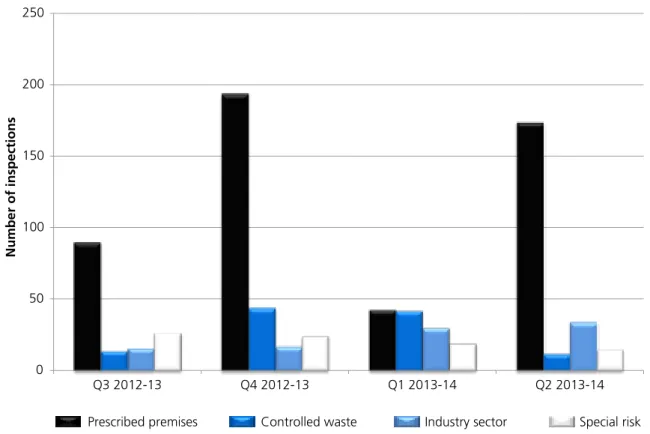As part of the changes to the machinery of government, the Department of Environment and Conservation (DEC) was separated into two agencies on 1 July 2013: the Department of Environmental Regulation (DER) and the Department of Parks and Wildlife (DPaW). There is no objection to this publication being copied in whole or in part, provided that there is proper acknowledgment of any material quoted or reproduced from the publication. This report, and a summary of approval report, is available on the Department of Environmental Regulation's website at www.der.wa.gov.au/.
This document is available in other formats and languages upon request from the Ministry of Environmental Regulation.
Introduction
Works approvals and licences
Introduction
Performance
For project approvals other than major resources (other projects), DER has set a goal to decide on 80 percent of works approval and license applications within 60 working days. In January 2010, tracking mechanisms were introduced to regularly monitor the progress of DER performance improvement applications in meeting the target timeframe for all work and license approvals. In the second quarter of 2013-2014, DER decided on twenty-two other applications for approval of project works.
The average processing time for other works approval requests fell to 37 days this quarter, compared to 49 days in the prior quarter. Sixty-four percent of the other project permit applications were decided within the target period in the second quarter of 2013-2014. The quarterly figures for other works approvals and permit applications are summarized in Tables 2.3 and 2.4 and Figures 2.3 and 2.4.
DER aims to decide on 100 percent of all new permit applications within the legal term of 30 days. In the second quarter of 2013-2014, DER continued to meet its target, with 100 percent of the 176 applications being decided within the statutory 30-day deadline.
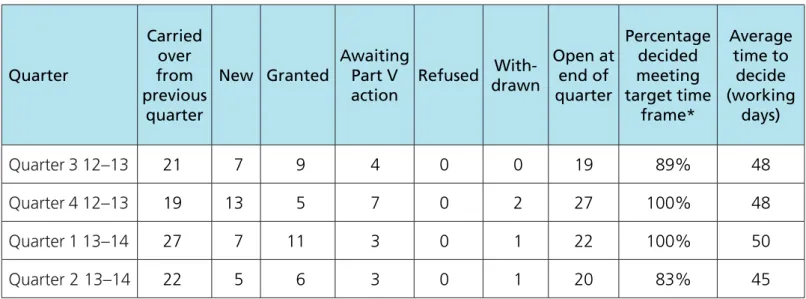
Environmental compliance
Introduction
Performance
Controlled Waste Compliance Program The purpose of the Environmental Protection (Controlled Waste) Regulations 2004 is to ensure the safe and authorized transport of controlled waste on public roads in Western Australia. The regulations impose obligations on generators, transporters, handlers and landfills of controlled waste, and the compliance program focuses on these obligations. A target of 20 inspections of retail outlets selling compost products was set for the 2013–14 programme, of which 100 per cent was achieved in the first quarter of the programme.
DER is in discussions with manufacturers of non-compliant products identified during these inspections to ensure compliance with the regulations. Asbestos Management in Construction and Demolition (C&D) Waste Compliance Program The Guidelines for the Management of Asbestos at Construction and Demolition Waste Recycling Facilities were released on 18 December 2012, and outline procedures for managing the risk of asbestos contamination from raw materials and products at C&D waste recycling facilities. The guidelines apply to any premises licensed under Schedule 1 of the Environmental Protection Regulations 1987 that accepts, stores and/or processes C&D waste.
The amended conditions include the submission of an assessment report, which assesses operations at the facilities in accordance with the provisions of the guidelines and, where gaps in compliance with the guidelines are identified, provides an environmental improvement plan. After the implementation of the plan, the premises are re-inspected and compliance with the guidelines is assessed. DER is continuing to work with licensees who have not yet achieved compliance with the guidelines.
The compliance program is expected to be completed by the end of the third quarter of 2013-2014. Under section 4.3 of the guidelines, permit holders who can demonstrate to DER that they have complied with the guidelines for an uninterrupted six-month period may request DER for a reduced sampling rate of recycled product produced on site. DER is currently in discussions with applicable permit holders to ensure that asbestos management plans are appropriate and in compliance with asbestos guidelines.
Compliance program for bulk port facilities The compliance program for bulk port facilities is planned for the financial years 2013-14 and 2014-15. Following the collection of this information, inspections of port facilities will commence in the 2014-15 financial year. This program has been established to assess industrial premises across regional areas against the general provisions of the Environmental Protection Act 1986 and any subsidiaries.
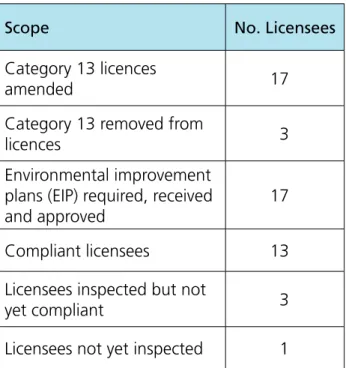
Native vegetation clearing permits
Introduction
Performance
Cleaning for the purposes of mineral production, mineral exploration, oil production, petroleum exploration (for applications managed by DER and DMP), and other state development (including state agreements) managed by DMP by authority. This could include purposes such as the construction and maintenance of roads, buildings or facilities and other infrastructure. Clearing by utilities including Water Corporation, Western Power, Horizon, Main Roads Western Australia, Verve Energy, Telstra, Alinta, Westnet Rail and Public Transport Authority.
This may include purposes such as infrastructure construction and maintenance, railway construction, road construction and maintenance. Tables 4.3 and 4.4 on the following pages show the number of decisions made on clearance of permit applications by DER and DMP, including the percentage of applications decided within target timeframes. Statistics are given on how many decisions were subject to 'stop the clock', and the average time (in days) that applications were in 'stop the clock'.
This status is granted when an initial assessment has been carried out and, based on the result of the assessment, significant environmental or planning issues have been raised, so that the CEO, before a decision is made, requires additional information in accordance with section 51E, subsection . 1, letter d). The EP Act. This status is also granted when the applicant requests in writing that the process be put on hold. This status is granted when, based on an initial assessment, the Chief Executive considers that the application raises such significant environmental, planning or other relevant issues that it is likely to be rejected.
The Director General shall give the petitioner a period of not less than 30 days to respond to meet the requirements of natural justice. This status is granted when the EPA notifies the DER/DMP that a proposal has been referred and that it is restricted from making a decision that could implement the proposal or a related proposal under sections 41 and/or 51F of the European Parliament Act. This figure is not the same as the previous reporting period due to the correction of data for the first quarter of 2013.
The total/mean values in Table 4.5 may not match the total/mean values in Table 4.6. Breakdown of reasons for 'stop the clock' by number of incidents and average number of days per incident*. The total/mean values in Table 4.6 may not match the total/mean values in Table 4.5.
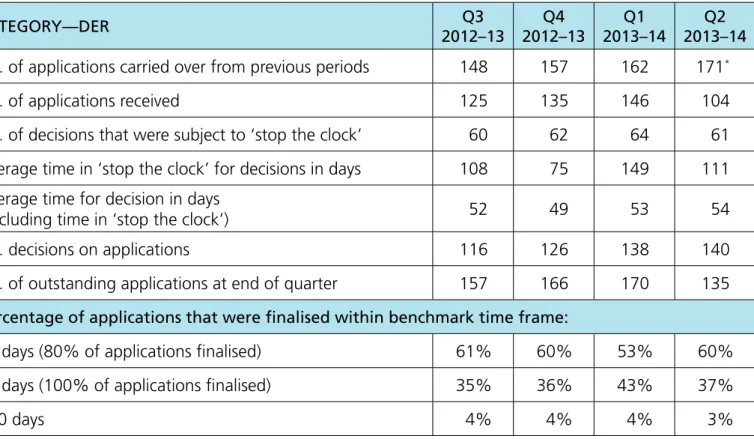
Contaminated sites
Introduction
Performance
Form 1 received in the last four weeks of the quarter still within 45 legal days, which will be processed in the next quarter. For example, MARs may be required when a site is a source of contamination that has been moved off-site to affect other properties, or if a site is subject to a regulatory notice, or if an investigation and remediation is conducted pursuant to a planning or . Some MARs are reviewed only by DER (in addition to routine consultation with DH as part of the classification process).
For other MARs, DER requires specialized technical advice from other agencies before processing the MAR can be completed (for example, where asbestos or radiological contamination is present, or where a quantitative human health risk assessment has been performed). In addition, three MARs carried over from the previous reporting period were processed, bringing the total number of MARs processed within this period to 11. The average processing time for all MARs completed during this reporting period was 36 days, exceeding DER's target of 21 days (three weeks) as several responses from other agencies were delayed.
The average processing time for the four MARs that did not require referral to other agencies was 15 days, within the 21-day target (see Table 5.2).

Environmental enforcement
Introduction
Performance
1 Quarterly breakdown shows sanctions taken at the end of each quarter for issues received during the quarter. 3 An environmental protection notice is a legal notice issued under section 65 of the Environmental Protection Act 1986. 4 An infringement notice is a modified sentence for an alleged offense requiring the payment of a fine or the choice of taking the matter to court is required.
5 A stop work order is a statutory order issued by the Minister under section 69 of the Environmental Protection Act 1986. 6 An education letter is non-statutory advice to a person or business reminding them of their responsibilities under the Environmental Protection Act of 1986 7 A warning is an unlawful notification to an offender that a breach of legislation has occurred and that it has been recorded.
8 A statutory direction/notice is a written direction requiring certain actions to be taken or ceased within a specified time, for example a pollution prevention notice. 9 An amended penalty is a statutory notification that an offense has occurred and that, in DER's opinion, the offense has met the prescribed legal requirements to minimize and remedy the environmental impact. 10 A DER prosecution begins when a complaint is made (or sworn) that an entity has committed an offense under the legislation.
Following the machinery of government changes and the establishment of the DER on 1 July 2013, the Q2 figures for 2013–14 do not include actions/sanctions taken by the SRT. 12 DER m may amend or revoke an existing license for conservation, preservation, protection, improvement and management of the environment. 13 A prescribed action is any physical intervention undertaken by DER to correct a breach of legislation or when.
If this happens, the occupant or polluter may be sued for the costs of the clean-up. Such action will only be taken where permitted by law and in accordance with that law. 14 A vegetation conservation notice is a legal notice given under Section 70 of the EP Act when the CEO of DER has reasonable grounds to believe that unlawful clearing of native vegetation is likely to take place, is taking place or has taken place on the country.
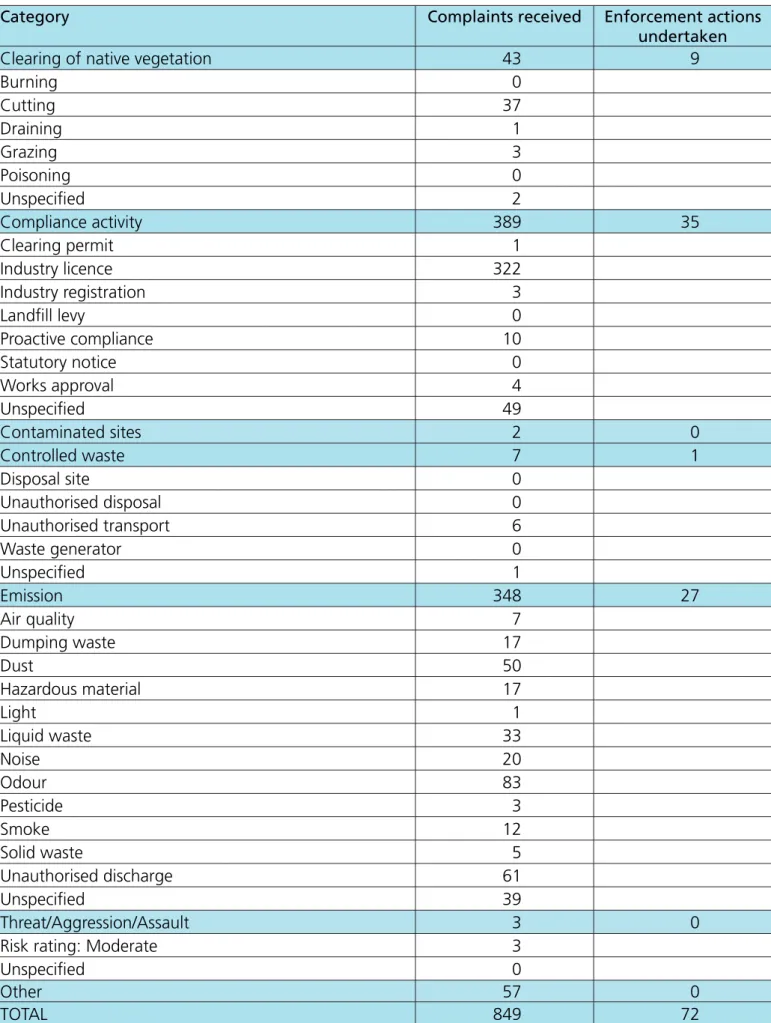
Contact details
Department of Environment Regulation
Quarterly reports
